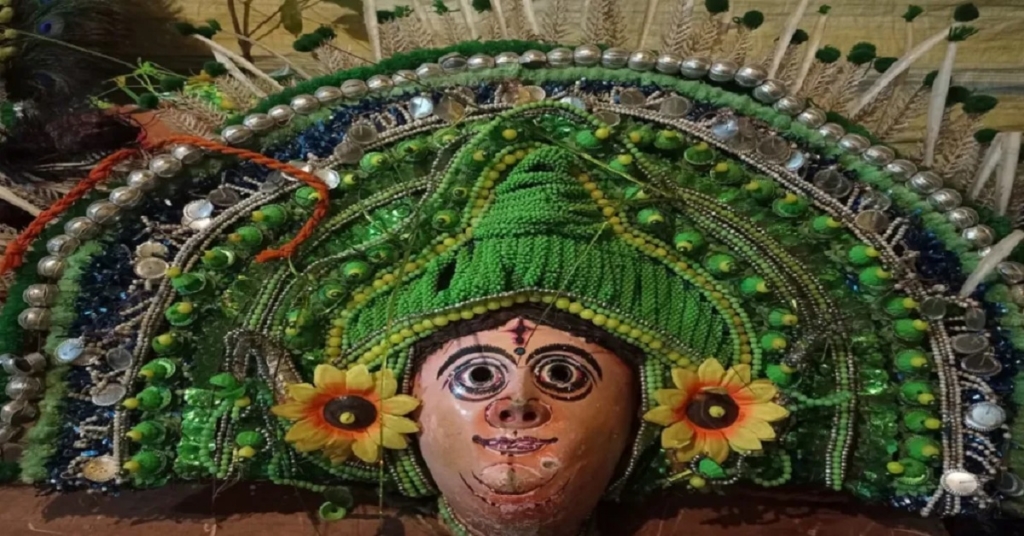Charida is a beautiful and quiet village in the hills of Ayodhya in Purulia district of West Bengal. Yes! There is an Ayodhya here too, and the area falls under the Baghmundi police station. The essence of this lovely village is visible even before you reach it, the road leading to it is lined with rows of Chhau mask shops on both sides of the road. The Chhau masks are made by the villagers themselves, who work hard to create hundreds of these unique masks.
The Chhau masks made here are not only used for dancing, but now have been in demand as decor items from across the country and even abroad. In Purulia, Chhau groups collect the necessary Chhau masks from this village. In Charida, around 300 artists from a 100 families make Chhau masks. Some families sell only small masks for house decoration, while others sell both small and larger ones used for dancing. The masks sell for a mere Rs 30 to Rs 130 rupees, even though each takes hours to make andis painted by skilled artisans.
CJP’s Grassroots Fellowship Program is a unique initiative aiming to give voice and agency to the young, from among the communities with whom we work closely. These presently include migrant workers, Dalits, Adivasis and forest workers. CJP Fellows report on issues closest to their hearts and home, and are making impactful change every day. We hope to expand this to include far reaching ethnicities, diverse genders, Muslim artisans, sanitation workers and manual scavengers. Our raison d’etre is to dot India’s vast landscape with the committed human rights workers who carry in their hearts Constitutional values, to transform India into what our nation’s founders dreamt it to be. Please Donate Now to increase the band of CJP Grassroot Fellows.
Chhau masks are made of paper, cloth and clay and go through various processes, beginning with the structure or mould of the mask. The mask made of clay is dried in the sun, then the ash is spread on the dry mould after this paper soaked in glue is placed on top of it. A coat of mud is applied and it is dried again. Once dried, a cloth layer is glued on and the mask is polished. The mud coat is removed and the mask is then painted according to the character it represents. The painted mask is decorated with ‘jewellery’ made of wool, jute, tin, bamboo twigs, plastic flowers, and beads.
Purulia’s Chhau dance has gained international fame as the masked dance. Now this dance style of the village people of the village has become a subject of research. The first things that catches the eye of the spectators of Chhau dance are the costumes of the artists. The crowning glory of this outfit is the mask. Originally based on mythology, the masks of Durga-Mahishasur, or Ram-Lakshman-Sita are often worn in the dance. Chhau is also performed in West Bengal, Jharkhand and Mayurbhanj in Odisha. However, Chhau masks are not used in Mayurbhanj.
Purulia’s touch is special for the Chhau mask, says Giyas, a local artist, “It is great when tourists come and shop here during the winter season. At this time I earn two-three thousand rupees a month. I have to save this money to feed my family all year round.” According to him, Purulia was devoid of tourists due to the long lockdown and the industry collapsed. “Today there is little money in the house, if my masks are not sold soon, I will be in trouble,” he added.
Purulia’s Chhau artists (dancers) do receive a small allowance from the state government. But the mask makers do not get any such allowance. They now hope sales pick up soon, else their masks will be lost forever.
This report is part of CJP’s Grassroots Fellowship Program, and has been written by researcher Ripon Sheikh, who is travelling around rural Bengal, tracking and documenting social and cultural movements of indigenous people.
Meet CJP Grassroot Fellow Mohammed Ripon Sheikh
This young man, who has graduated with a B.Sc degree from Burdwan University, loves trivia. Sheikh’s passion to research and seek “unknown information about World History” has earned him many medals and trophies at various University and state-level Quiz championships, and youth festivals. Sheikh is a born orator and a natural community leader. He has the potential to represent his community, state and country at a global level one day. His immediate goal, however, is to find a job so he can support his parents.
Related:
Have you ever met the man behind a Behrupiya?
Pattachitra: Where paintings tell a story
Jute farmers, and their fields of gold
CJP Impact: Churki Hansda goes from being called “Dayan” to “Di”
What happens when a ‘school’ drives to the students?

